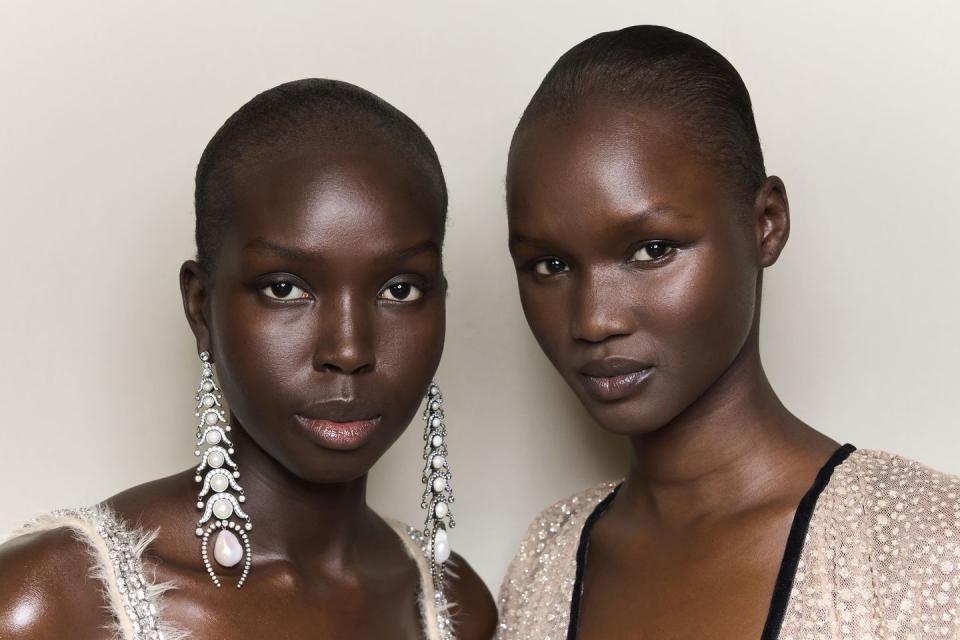Everything You've Ever Wondered About Retinol, Explained

There are very few ingredients that you can simply slather on, mix together and layer to your heart's content – but least of all when it comes to retinol. The star active might be one of the most popular mainstays in the world of skincare, but it's also one of the most misunderstood; it requires careful education, research and understanding to reap the glow-boosting rewards.
And trust us: when used correctly, in the right percentage for your skin type, in accordance with new retinol guidelines, and in tandem with the right cocktail of ingredients, retinol can really improve your skincare line-up for the better.
FIND OUT MORE ON ELLE COLLECTIVE
So then, how exactly do you use retinol to its maximum potential? And where do you even start if you're a complete retinol beginner? From schooling up on the best retinol formulas, to knowing whether a serum or cream is right for you, consider this your cut-out-and-keep guide on exactly how to use retinol in your current skincare routine.
Firstly, what does retinol do?
Part of the retinoid family and derived from vitamin A, retinol helps stimulate skin cell turnover which causes natural exfoliation; it also helps reduce the appearance of fine lines and wrinkles, improves skin texture and hyperpigmentation, treats acne, and unclogs pores, leaving you with clearer, smoother-looking and more radiant skin.
There are a number of different retinoids to choose from. 'Retinoids are a class of synthetic and naturally occurring vitamin A compounds and derivatives that include retinol and retinoic acid, which are naturally occurring in humans,' explains La Roche-Posay Consultant Dermatologist, Dr Justine Hextall. 'Some retinoids, such as retinoic acid (tretinoin) are available with a prescription only, while others, such as retinols, and retinal (retinaldehyde), are cosmetic and available over the counter.' Retinol is the most popular among the group of retinoids when it comes to over-the-counter formulas.

Benefits of retinol
Helps boost skin cell turnover which provides natural exfoliation and unclogs pores
Improves the appearance of fine lines and kickstarts the production of collagen
Minimises acne by getting rid of bacteria and reducing oil production
Improves signs of hyperpigmentation and acne scars thanks to improving the skin's natural healing process
Improves the overall radiance, luminosity and texture of skin
Do's and don'ts for using retinol
Do check the percentages on the bottles before you purchase them; the maximum retinol percentage is now 0.3% for face and 0.05% for body, according to new legislations. If you are a retinol beginner, start low and build up from 0.1%
Do give your skin time to adjust to the formula, only using it once a week to begin with before building up to twice and then three times
Do always use sunscreen in the morning, following retinol application the night before
Do ensure you're using a ceramide-rich moisturiser to help strengthen the skin barrier
Don't apply on the eye area. As Dr Hextall notes, 'when first getting used to retinol, the skin in this area is thinner and lacks oil glands' making it more delicate
Don't use other chemical and physical exfoliants that may irritate the skin, such as glycolic acid and lactic acid
Don't combine retinol with too many active ingredients, including vitamin C
Don't apply retinol in the morning, unless stated as safe to do so
Don't use retinol if you're pregnant
How often should you use retinol?
'This is one of the most common misconceptions I see daily in my clinic,' shares Dr Hextall. 'I frequently see individuals who are putting several "high concentration" active ingredients often several times a day,' she notes. 'I cannot emphasise enough how this really will not improve your skin: there is no substitute for a calm hydrated skin barrier.'
With so many active ingredients on the shelves and TikTok telling you to experiment with them all, playing DIY dermatologist is the worst thing you can do when it comes to retinol. Instead, introduce a retinol formula slowly by using it a couple of times a week, before increasing the amount; this will ensure you don't sensitise your skin and will reduce the risk of irritation.
'Choosing a retinol formulation does depend on skin type and specific skin issues,' adds Dr Hextall. If you're on the sensitive side, your routine and product will be a stark contrast to that of your oily skinned counterpart. 'If skin is oily and prone to breakouts, a retinol serum that is water or emulsion-based may be better suited to your skin type. Meanwhile, if skin is more mature, sensitive or prone to dryness then an oil or cream-based treatment may be able to deliver the active ingredients whilst soothing and hydrating skin,' she notes.
How much retinol should I use?
As to the question of how much: you want to apply a thin layer of retinol that covers your face. That will usually look like a pea-sized amount, according to dermatologists. Using too much of the formula can result in severe irritation, swelling, excessive dryness and peeling so be sure to be scrupulous and avoid overzealous application and layering.
Exactly how to use retinol for your skin type and concern
Retinol for acne
If you're considering using retinol to treat acne, the first thing you need to consider is what's caused the acne in the first place. 'Hormones stimulate the production of sebum or oil and it's the combination of oil and skin cells that block the follicles, which become inflamed and lead to acne lesions,' explains Dr Hextall. 'If we consider these steps and how to treat them, we can see why retinoids are so successful in the management of acne,' she notes.
Retinoids helps stimulate a turnover of skin cells which, in turn, unblocks the pores, helps reduce inflammation and oiliness and minimise the production of oil - meaning fewer breakouts. In the case of acne, you might be prescribed a retinol by your dermatologist or can consider an over-the-counter option.

Retinol for fine lines
Searching for a solution to minimise fine lines? Retinol is one of the only ingredients that's clinically proven to help with that. And if you're consistent with it, retinol can help improve the elasticity of your skin and minimise the appearance of fine lines.
'I recommend retinoids if an individual is looking to smooth fine lines, improve skin texture and reduce unwanted skin pigmentation,' notes Dr Hextall. ' Regarding the thinner skin around eyes where there is a paucity of oil glands, an oil-based retinol is preferable to reduce fine lines and hydrate the delicate skin.'
The strength of retinol is important here. As Dr Hextall warns, the stronger the retinoid the quicker you can see results - but equally, there's more risk of sensitivity and irritation. 'Start slowly and build up the strength and frequency of application,' she warns.

Retinol for pigmentation
Retinol has long been considered a salve for treating hyperpigmentation, scarring and discolouration. For this, Dr Ana Mansouri, aesthetic doctor for SkinCeuticals, recommends using retinol a few times a week, starting with once a week and building up the number. Ensure you are using a high-factor sunscreen as well as a vitamin C serum at night. 'These three pillar products will cover your bases for fading pigmentation overtime,' she adds.
Retinol for sensitive skin
Despite what you've been told, retinol isn't off limits for sensitive skin. 'I don’t always recommend using a retinoid every night, particularly if an individual has sensitive skin,' notes Dr Hextall. But if your skin is dry or sensitive, or both, Dr Hextall recommends applying a retinoid every other day. 'It is also important to balance active ingredients with soothing hydrating products to keep the skin barrier balanced and effective.' That could be moisture-locking ceramides, hyaluronic acid or squalane.
Look for a low percentage, such as 0.1 %, from brands like La Roche-Posay and Murad who have actively formulated retinols for those prone to sensitivity, dryness and irritation.
What to avoid when using retinol
As you've probably heard - or learned the hard way - retinol isn't exactly an easy going ingredient nor does it work in harmony with every buzzy new term in the ever-growing skindex. First of all, 'if you're using a retinoid, stop other chemical and physical exfoliants that may further irritate and dry skin,' says Dr Hextall.
You're best off avoiding using BHAs (like salicylic acid) and AHAs (glycolic acid and lactic acid) as these exfoliating acids combined with retinol could cause sensitivity and overexfoliation. Similarly, if you're using vitamin C, ensure that they're not combined in the same routine (use vitamin C in the morning; retinol at night).
'Avoid the eye area when first getting used to retinol; the skin in this area is thinner and lacks oil glands, hence it will be much more sensitive to skin irritants and will become dry and flaky,'says Dr Hextall. 'If there will be exposure to light, particularly in a hot climate make sure the retinol (if used overnight) is removed in the morning and a high-factor sun cream is applied,' she adds.
Should you put retinol on before or after moisturiser?
Then, of course, there's the business of when to apply your retinol. Is it before your serum, or after your moisturiser? The first step, or the last? Yes, the order of skincare can feel more complicated than navigating a never-ending to-do list. So, here's the deal: 'In the evening, after cleansing, I recommend applying your actives, such as retinol, then following with hydrating products,' says Dr Hextall. That means apply your retinol first before adding a layer of hydration. By applying a barrier-strengthening moisturiser (we love Medik8's Advanced Night Restore) after your retinol you reduce the risk of any irritation and ensure your skin stays in tip-top shape.
Is 0.1% retinol effective?
Retinoids, as you know, come in different percentages. 'There are prescription strength retinoids like Tretinoin and Adapalene, but retinols that are available over the counter are less potent,' explains Dr Hextall. But tat doesn't mean that a lower strength retinol isn't effective - and if your skin is sensitive it might just the ticket for you.
'Lower percentage retinol has been shown to be just as effective as high strength retinol; it just takes a little longer. One of the advantages of over-the-counter retinoids is that they tend to be more tolerable and are ideal for ensitive skin,' she says.
'You can start with anything from 0.1 – 0.3% and see how you get on - ideally you want to increase the strength of your retinol once your skin is no longer showing signs of sensitivity (including possible redness and some flaking); it may be that at a low percentage your skin doesn’t show sensitivity at all,' says Dr Hextall. Because, when it comes to retinol, less can truly sometimes be more.
How long should I use retinol for before I see results?
Unlike hyaluronic acid and vitamin C, when it comes to retinol, it can often feel like an eternity before your hard work pays off. Though you may notice visible differences prior, you can expect to see changes in your skin after 12 weeks of consistent use.
As for the best retinol for the job? See our ELLE-approved edit below for every skin type and concern:
ELLE Collective is a new community of fashion, beauty and culture lovers. For access to exclusive content, events, inspiring advice from our Editors and industry experts, as well the opportunity to meet designers, thought-leaders and stylists, become a member today HERE.
You Might Also Like


